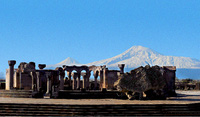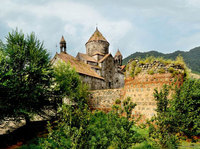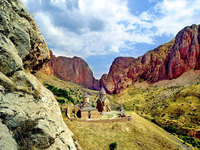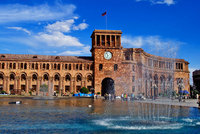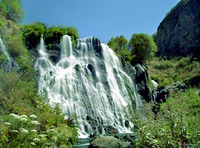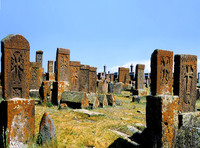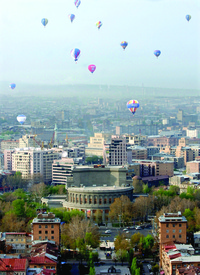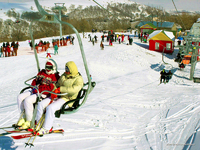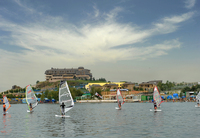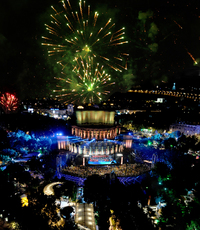General information about Republic of Armenia
Official Name
Republic of Armenia (RA), short: Armenia
Flag
The flag is tricolor with three horizontal and equal alternating stripes of red, blue and orange(from top to bottom). The correlation between the width and length of the flag is 1/2.
The Coat of Arms of the Republic of Armenia is as follows: On a shield, positioned in the center, Mount Ararat is represented with Noah's Arch and the coats of arms of the four royal dynasties of the historical Armenia: from top to left - that of the Bargratunides, from top to right - that of the Arshakounides, from bottom to left - that of Artashesides, from bottom to right - that of the Rubenides. The shield is upheld by an eagle (on the left) and lion (on the right). There is a sword, as well as a branch of a tree, a bundle of spikes, a chain and a ribbon pictured below the shield. Golden is the main color of the Coat of Arms of the Republic of Armenia. The colors of the kingdoms of the historical Armenia are as follows: from top to left - red, from top to right - blue, from bottom to left - blue, from bottom to right - red, with orange-painted Mount Ararat positioned in the center on a shield. The foregoing colors emblematize the colors of the national flag of the Republic of Armenia.
The Anthem of the Republic of Armenia was adopted on July 1, 1991, by the Supreme Soviet of the Republic of Armenia. It is based on the Anthem of the First Armenian Republic (1918-1920). RA Law on the “Anthem of the Republic of Armenia” was adopted on December 25, 2006. The Armenian national anthem is “Our Fatherland”; lyrics by Michael Nalbandian, music by Barsegh Kanachian.
The Head of State
President
The Legislative Body
Unicameral National Assembly
The State Language
Armenian (belongs to the Indo-European family of languages)
The Capital
Yerevan city (community status)
Administrative Unit
Marz (total number of 10), communities (total number of 502)
Including:
Urban: 49
Including: Yerevan city with 12 administrative districts
The national currency
Dram (the international recognition of AMD), that has been circulated since November 1993
Geografic Information
The country is situated in western part of Asia, occupies the north-eastern part of Armenian plateau – between Caucasus and Nearest Asia (the inter-river territory between the middle flows of the rivers Kur and Araks)
Area
29743 km2 (similar to the Belgium’s and Albania’s territory sizes)
Average Altitude Above Sea Level
1800 m (76.5% of the republican territory is on the height of 1000-2500 m above sea level)
State border
In the North with Georgia,
In the East with Azerbaijan,
In the West with Turkey,
In the South with Iran
The greatest extend
from North-West to South-East comprises 360 km
from West to East 200 km
Earth lowest point
The underflow region of Debed river 375 m
Mountain, Plateaux 36.4 % (in the Republic of Armenia)
The highest elevation
Peak of Aragats mountain 4090 m
The high mountaintops
Kaputdjugh 3906 m
Azhdahak 3598 m
Spitakasar 3555 m
Vardenis 3522 m
Water reserves
Annually comprise totally 8.5 bln. m3, of which 6.54 bln. m3 - surface water flow
The longest rivers (in the Republic of Armenia)
Araks 158 km
Akhuryan 186 km
Vorotan 111 km
Debed 154 km
Hrazdan 141 km
Aghstev 81 km
Lakes
Sevan (as of 31.12.2010) surface 1270.8 km2 (28 rivers and small rivers flow in Lake Sevan, only Hrazdan river originates from the lake)
the height above sea level 1899.90 m
Arpi surface 22.0 km2
the height above sea level 2021 m
Sev surface 2.0 km2
the height above sea level 2666 m
Akna surface 0.80 km2
the height above sea level 3032 m
The average temperature
in January -2.3 C
in June +16.3 C
The quantity of precipitations, mm
652.6
Time
The average time, GMT +4 hours
Climate
Dry-land
Demographic Information
Population
2976.8 thousand (as of January 1, 2023)
Ethnic Breakdown
Armenians (98,1%), Yezidis, Russians, Assyrians, Ukrainians, Kurds, Greeks, and Others (According to the 2011 census results)
Religion
Christian (Armenian Apostolic Church), the majority of the population profess to be Christian
Historical Information
On 23 August, 1990
The declaration on state independence of the Republic of Armenia was adopted
On 21 September, 1991
The referendum on independence declaration was held
On 21 December, 1991
Armenia became a member of the CIS
On 30 January, 1992
Armenia became a member of the OSCE
On 2 March, 1992
Armenia became a Member of the United Nations
On 15 May, 1992
Armenia became a member of the Collective Security Treaty Organization
On 28 May, 1992
Armenia’s accession to the International Monetary Fund
On 25 June, 1992
Armenia’s accession to the Organization of the Black Sea Economic Cooperation (BSEC)
September, 1992
Armenia became a member of the World Bank
On 25 January, 2001
Armenia became a member of the Council of Europe
On 5 February, 2003
Armenia became a member of the World Trade Organization
On October 13, 2012
The Republic of Armenia became a full member of the International Organization of Francophonie
On October 10, 2014
At the session of the Supreme Council of the Eurasian Economic Union signed was the agreement on the Republic of Armenia's accession to the EEU
On November 24, 2017
The Republic of Armenia and European Union concluded Comprehensive and enhanced partnership agreement.
